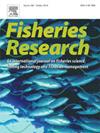物种以下和物种之外:用于欧洲市场鳕鱼产品地理可追溯性分析的DNA工具
IF 2.2
2区 农林科学
Q2 FISHERIES
引用次数: 0
摘要
DNA技术已被证明是监测海产品贸易和提高透明度的有效工具。它突出了全球范围内海鲜品种标签错误的问题,并引起了政策制定者、政府当局和其他利益相关者的兴趣。尽管遗传方法在海产品可追溯性方面已被证明是成功的,但在一个物种中探索地理捕获位置标签错误的研究仍然很少。准确披露野生捕捞鱼类的捕捞地点对可持续海鲜管理至关重要,但核实这些信息仍然很困难。评估捕捞地点的工具正在增加,并为扩大对海产品错误标签的调查提供了前所未有的机会。诊断性单核苷酸多态性(snp)已广泛应用于群体遗传学,并有可能揭示海产品欺诈的趋势。在这项研究中,我们展示了一组9个诊断snp的效率,用于鉴定两个大量捕捞的鳕鱼种群,东北北极鳕鱼和北海鳕鱼,并对在四个欧洲国家销售的大西洋鳕鱼的捕捞地点错误标签进行了市场分析。我们的研究结果表明,廉价的诊断分子工具可以有效地监测捕获地点的错误标记,并讨论了如何改进该方法以最大限度地减少错误和最大化效用,从而加强治理,增强可持续性和增强消费者信任。本文章由计算机程序翻译,如有差异,请以英文原文为准。
Below and beyond the species: DNA tools for geographic traceability analysis of cod products in European markets
DNA technology has been shown as an effective tool to monitor seafood trade and improve transparency. It has highlighted seafood species mislabelling on a global scale and has attracted the interest of policy makers, government authorities, and other stakeholders. Despite the proven success of genetic methods in seafood traceability, studies exploring the mislabelling of geographic catch location within a species remain rare. Accurately disclosing the catch location of wild-caught fish is crucial for sustainable seafood management, but verifying this information remains difficult. Tools to evaluate catch location are on the rise and offer an unprecedented opportunity to expand investigations of seafood mislabelling. Diagnostic Single Nucleotide Polymorphisms (SNPs) have been used extensively in the context of population genetics and have the potential to reveal trends in seafood fraud. In this study, we demonstrate the efficiency of a set of nine diagnostic SNPs for the identification of two heavily harvested cod populations, the Northeast Arctic cod and the North Sea cod, and conduct a market analysis of catch location mislabelling of Atlantic cod sold in four European countries. Our findings suggest that inexpensive, diagnostic molecular tools can effectively monitor mislabeling in catch locations and discuss how the method can be enhanced to minimize errors and maximize utility, towards strengthening governance, enhancing sustainability, and boosting consumer trust.
求助全文
通过发布文献求助,成功后即可免费获取论文全文。
去求助
来源期刊

Fisheries Research
农林科学-渔业
CiteScore
4.50
自引率
16.70%
发文量
294
审稿时长
15 weeks
期刊介绍:
This journal provides an international forum for the publication of papers in the areas of fisheries science, fishing technology, fisheries management and relevant socio-economics. The scope covers fisheries in salt, brackish and freshwater systems, and all aspects of associated ecology, environmental aspects of fisheries, and economics. Both theoretical and practical papers are acceptable, including laboratory and field experimental studies relevant to fisheries. Papers on the conservation of exploitable living resources are welcome. Review and Viewpoint articles are also published. As the specified areas inevitably impinge on and interrelate with each other, the approach of the journal is multidisciplinary, and authors are encouraged to emphasise the relevance of their own work to that of other disciplines. The journal is intended for fisheries scientists, biological oceanographers, gear technologists, economists, managers, administrators, policy makers and legislators.
 求助内容:
求助内容: 应助结果提醒方式:
应助结果提醒方式:


